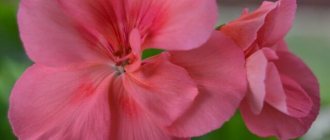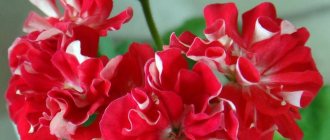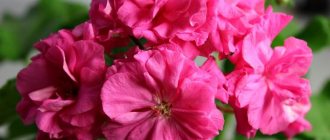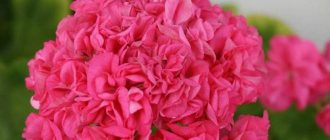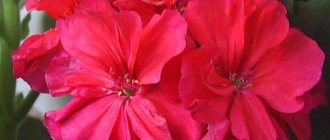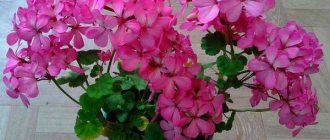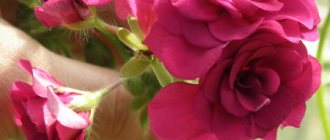How to properly care?
Pelargonium Norland - grows and blooms well in a pot on the windowsill, but in order for the flowering to be abundant, you will have to take care of it. The rules are not complicated, but in order for the plant to be strong and healthy, it is advisable to follow them unquestioningly.
Watering
In summer, watering should be plentiful and very frequent, since during hot periods pelargonium flower buds may fall off due to lack of moisture. But at the same time, you should not over-water the plant, and if moisture has accumulated in the pan after watering, it must be drained - this will prevent rotting of the roots.
When watering, use only settled, soft water that does not contain limescale. There is no need to spray pelargonium during flowering; it can not only lose its decorative effect, but also rot.
Top dressing
For Norland pelargonium, only mineral fertilizers are applicable. Feeding the plant is strictly prohibited. But this applies not only to this variety; all geraniums have a negative attitude towards organic fertilizers. It is better to apply mineral complexes during the period of active growing season and rapid flowering. Feeding is done once every 2 weeks in summer. As for the winter period, there is no need to add additional food.
Transfer
- Pelargonium does not like frequent transplants, so it is obviously better not to touch it until the pot becomes cramped. This is very easy to determine - the roots of the plant will stick out from the drainage holes.
- When replanting, you should not take a large pot - pelargonium will stop blooming; each new pot should be 1.5 cm larger than the previous one. Flowering begins only after the earthen ball is completely filled with roots.
- The soil in the pot must be completely replaced; to do this, carefully free the roots from the old soil, being careful not to damage them, then transfer the pelargonium to the new soil. After replanting, fertilizing is not carried out for a month and a half, since the new soil is already nutritious.
- You should not touch the plant during the active growing season; you need to wait until the pelargonium fades and goes into a dormant state. It will also tolerate transplantation well in early spring.
Attention! Many gardeners claim that after pelargonium grows to 30 cm in height, it is no longer necessary to replant it
Trimming
Pelargonium Norland needs high-quality and regular pruning. This is the only way to form a beautiful, compact and dense bush with large double flowers.
This process is carried out in the spring, the shoots are shortened by a third. Pruning allows you to stimulate the flower to form new shoots and bloom luxuriantly. If you do not pinch and trim, the geranium will stretch tall, the lower leaves will fall off the stems and you may not even get flowers. In the fall, dry and weak shoots are removed from the bush so that during the dormant period the pelargonium gains strength for new flowering.
Video tutorial on pruning pelargonium:
List of varieties of tulip-shaped pelargonium for beginners and experienced gardeners
Only 14 hybrid varieties are known, which belong to the group of tulip-shaped pelargoniums. You can see them in the photo of geraniums below and read a short description. I managed to collect a list of the best hybrids and their visual representation (photo) for beginners and experienced pelargonium lovers.
Patricia Andrea or "Patricia Andrea" is a vigorous zonal variety with shiny leaves. In groups, single, deep salmon-pink flowers that do not fully open resemble the shape of a half-open tulip.
Conny is a dwarf variety. Tulip pelargonium Conny is spectacular. Its decorative foliage is carved. The name Conny means “cutting” in Russian. This symbolizes the low stature of the variety. But the red velvety buds in a dense bouquet look incredibly beautiful, despite the small size of the bush.
Tmma Fran Bengtsbo is a large pelargonium variety. Geranium grows up to 80 cm. It forms side shoots. The bush requires formative pruning, as it can seriously grow. This results in the loss of decorativeness not only of the foliage, but also of the buds themselves. A flower of whitish-pink petals with a jagged edge. The bud is slightly elongated.
Helma is a dwarf plant with large inflorescences (on average 30-35 flowers in a bouquet). The buds are orange-red and the foliage is a soft green hue.
Red Pandora is a hybrid with pink petals and carmine veins. The buds are not large, collected in dense umbrella inflorescences. The foliage is juicy, emerald in color with a velvety surface.
Lilian Andrea - the variety forms a compact bush with bright flowers. It blooms for a long time and very abundantly. The flowers look like tulips. They are raspberry in color. Corollas pointed at the apex. The foliage is velvety and soft to the touch.
Marbaska Tulpan - this variety of tulip-shaped pelargonium is rare. It has white flowers with a slightly pink tint. The leaves are green and bright. The plant is tall and requires shaping. During the flowering period, the inflorescences consist of buds that look like lush capsules.
Pink terry pelargonium in varietal diversity
Judging by the number of varieties presented, one can understand that this color is not uncommon for pelargonium. I will try to show the varietal diversity of pink terry geraniums.
Granny Barter - pale pink flowers. The buds are almost white. The petals have a rich shade towards the center of the flower. Large inflorescences look like bows. The bush is small, usually standard, like all other geraniums. Does not grow when formed using trimmings.
Norrland - lush pink inflorescences of densely double buds “fly up” above the stems on long strong shoots. The foliage is green, decorative. The flowers look more like blossoming peonies than roses, as the buds are very lush.
Passat – soft pink pelargonium with double flowers. The corrugated petals of the corolla complement the beauty. This makes the flower look like fluffy pompoms.
Shelk Moira – pink-orange geranium, salmon color. The variety amazes with the tenderness of the inflorescences. They can shimmer depending on the lighting. Some petals may be very rich, others paler. This is a Russian variety with dense inflorescences. The petals of the corolla are wavy.
Brookside Fantasy – This double pelargonium bushes are compact and deep green. Blooms abundantly, with pink flowers.
Highfield's Fancy - zonal pink - is another compact variety that does not require constant shaping pruning. The flowers are large and dense. They are deep pink with a subtle tint. In the center the bud is white or cream.
Highfield's Prima Donna is a soft pink variety. The foliage is velvety, dark green. It blooms with crimson buds with numerous petals. They have a small white eye. It may be light pink.
Use of fragrant pelargoniums
The question arises: where can all this splendor of smells be used? Rose-scented geraniums are suitable for flavoring teas. However, dried leaves should be used. To preserve the aroma as much as possible, they need to be plucked from the plant, placed one at a time in a dark and well-ventilated place and not stirred up again. This way the essential oil will be preserved better. Then mix the dry leaves with tea. In addition, they, like pelargoniums with a citrus scent, can be used to prepare cool summer drinks, desserts, and jellies. Citrus-scented leaves can be used to season fish dishes and flavor vinegars and oils for salad dressings.
Varieties of indoor plants with names and what they look like
Today there are many varieties of this pelargonium. Each of them has distinctive features.
Today there are many color variations of pelargoniums known
Angel Viola
This culture is a compact plant, which is characterized by long and lush flowering. All summer the bushes can be decorated with pink flowers. A characteristic feature is the contrasting crimson spot on the petals.
Angeleyes Orange
This plant has deep orange petals. The appearance of the bush is also improved by small leaves that have an openwork structure.
For reference! Pelargonium Orange is perfect for hanging structures.
Michael
This variety is characterized by small bushes and flowers with many petals. They have a cherry center and a white border.
How to properly care?
Temperature
In summer, the flower prefers to be in a temperate warm climate. The temperature will be 17-23 degrees Celsius. Planting outside is done only after the danger of frost returning has passed. At temperatures of 12 degrees and below, flowering stops. Heat is also unacceptable for the plant, especially indoors. You can tell that a flower is cold by its reddened leaves.
ATTENTION! With the arrival of autumn, it is better to gradually lower the temperature and water the flower abundantly. Growth should not be active, otherwise the plant will begin to stretch and become exhausted in poor light.
Winter period
In winter, pelargonium zonartik is kept in a greenhouse or glassed-in balcony. The temperature should not fall below +6 degrees at night and +12+15 degrees during the day. On sunny days, open windows for ventilation to avoid overheating. In winter, excellent air circulation is important for the flower. Do not place pots close to each other. If necessary, thin out the crowns. This will prevent the development of fungal diseases.
Water in winter infrequently and sparingly. Do this from pallets, carefully measuring the amount of water and time for the next watering throughout the entire container. Moreover, the top of the soil should be dry. Overwintering of pelargonium zonartik can take place in other ways:
- This method involves saving plants as cuttings that have already taken root. In this case, the mother plant is thrown away. This method is used for summer growing pelargonium outdoors.
- This method is also used for keeping flowers outdoors. Before frost, remove the plant from the soil with its roots and shake off the excess soil. Cut the flower and wrap it in paper. Place in a cool basement. Choose a room with excellent ventilation and high humidity. Otherwise, the plant may dry out.
These two methods can be combined: first take cuttings, and then send the mother plant to a cool room for the winter. Wintering occurs at the warmest time and lasts 3 months (November-February). At the end of January and beginning of February, when daylight hours begin to increase, pelargonium begins to gradually awaken.
Watering
REFERENCE! Pelargonium zonartik is a moisture-resistant plant, but at the same time it is susceptible to fungal diseases. So it’s better to underwater it than to overwater it.
In summer, watering is carried out as the top layer of soil dries. In this case, the plant should be in a warm and sunny place. In winter, limit watering, but do not allow the soil to dry out completely. Excessive moisture can be recognized by drooping and limp leaves. In addition, symptoms of gray rot will begin to appear.
In severe cases, the stem rots, which ultimately leads to the death of the flower. Another symptom of excess moisture is the “sores” that form on the underside of the leaves. When the earthen clod dries out, flowering stops, the leaves turn yellow, and the edges die. For irrigation, only settled, warm and soft water is used. Air humidity is not important for pelargonium zonartik.
These flowers do not need spraying. Excessive humidity and stagnant air promote the development of fungus.
Feeding
Fertilizing should be introduced with each watering, while reducing the dosage. For example, if moistening is carried out daily, then the weekly fertilizer rate should be divided by 7-10. Apply the resulting dosage to each watering. If the lump of earth has dried out between irrigations, moisten it with clean water.
During the winter rest period, fertilizing should not be applied if the temperature is low and the plant is completely resting. When slight growth of the flower is visible, the introduction of fertilizer should be restored to ¼ dosage. After rooting the cuttings, fertilizer with a high concentration of nitrogen is used.
ATTENTION! To feed young plants that are too early to bloom, use a complex universal fertilizer. Before flowering, 2-3 months, you will need to use a fertilizer with a high concentration of potassium.
If there are signs of chlorosis, treat with magnesium sulfate and iron chelan.
Diseases and pests
Like all house plants, Norland pelargonium can face various diseases, as well as attacks from harmful insects. Next, we will find out what dangers most often threaten this plant.
Gray mold in this case is one of the most common diseases. The disease is fungal in nature and spreads quite quickly. Rot appears as gray characteristic spots on various parts of the plant: from the stem to the petals.
Note that the development of this fungus is facilitated by excessive moisture of the plant, as well as too much nitrogen in the soil.
For treatment, it is recommended to use systemic fungicides:
- Rovral.
- Vitaros.
- Fundazol.
In addition, pelargoniums are threatened by other types of rot: stem and root. Let us note that the causes of most cases of diseases with putrefactive pathologies are mistakes made when caring for the plant.
Of pests , Norland is the most dangerous:
- Whitefly - eats the fleshy parts, which causes the bush to wilt and stop flowering.
- Mealybug - secretes white mucus, which then covers the surface of the leaf blades. Over time they begin to turn black.
Insects lead to the cessation or slowdown of the growth and development of the flower, its weakness, lethargy, and decreased decorativeness. To get rid of pests, it is necessary to use systemic insecticides.
Features of plant flowering
Anita is a variety of pelargonium characterized by lush flowering. With proper care it can last quite a long time. During the season, several inflorescences appear on one flower, which both replace each other and bloom simultaneously.
Pelargonium Anita
Period of activity and rest
The period of activity begins with the onset of spring, when the formation of buds begins. The flowering season is long, several months. Most often, Anita pelargonium blooms throughout the summer months until mid-autumn, when the temperature drops and daylight hours are noticeably reduced. The variety requires mandatory rest at low temperatures, reduced watering and no fertilizers. During the winter months, Anita needs to be provided with all these conditions. If she does not rest and accumulate strength for the new season, flowering may not occur.
Types and shape of flowers
The shape of the flowers is round, the inner petals are always tightly closed, so the middle is always closed. The color is very delicate, thin, pinkish. Externally, the flowers of this pelargonium are very reminiscent of rose flowers.
How to care at home
If you follow all the rules of care, the flower will not cause problems or troubles.
Lighting
Pelargonium Norland needs good lighting, however, it does not tolerate direct sunlight. Therefore, sparse shade or artificially created shading at midday is best suited for it.
Note that under the influence of the scorching sun the plant loses its decorative properties and may categorically refuse to bloom.
However, if you grow Norland pelargonium in conditions of severe lack of light, the plant will form lush greenery, but may refuse to bloom.
Temperature
This plant is not thermophilic, and moderate air temperatures suit Norland best. So, the average daily temperature in summer should be +18-25 degrees, and in winter - +10-12 degrees.
Note that this flower feels very good outdoors, so in the summer, if possible, it is recommended to take the pot to the balcony, terrace, veranda, or garden. When ventilating the plant, you should not create strong drafts; they have a very negative effect on flowering.
Watering
The soil must be constantly moist, so it is necessary to water regularly. Their frequency will depend on the season: in the hot summer, the flower is watered at least 3 times a week, but with the arrival of winter, the frequency of watering should be reduced to 1-2 times.
To prevent excess water from accumulating in the ground, it is loosened after each watering. The water must be of high quality and clean; tap liquid must not be used. First, it is left to stand for almost 5-6 hours in a wide and shallow container. Stir it from time to time to remove all the chlorine. The water temperature should be identical to room temperature.
Pelargonium Norland does not need spraying. Moreover, drops of moisture getting on the leaves and buds can lead to the plant losing its decorative properties and even to disease and rotting.
Feeding
For Norland pelargonium, only mineral fertilizers are applicable. Feeding the plant is strictly prohibited. But this applies not only to this variety; all geraniums have a negative attitude towards organic fertilizers.
It is better to apply mineral complexes during the period of active growing season and rapid flowering. Feeding is done once every 2 weeks in summer. As for the winter period, there is no need to add additional food.
Trimming
Pelargonium Norland needs high-quality and regular pruning. This is the only way to form a beautiful, compact and dense bush with large double flowers.
This process is carried out in the spring, the shoots are shortened by a third. Pruning allows you to stimulate the flower to form new shoots and bloom luxuriantly. If you do not pinch and trim, the geranium will stretch tall, the lower leaves will fall off the stems and you may not even get flowers.
In the fall, dry and weak shoots are removed from the bush so that during the dormant period the pelargonium gains strength for new flowering.
Transfer
- Pelargonium does not like frequent transplants, so it is obviously better not to touch it until the pot becomes cramped. This is very easy to determine - the roots of the plant will stick out from the drainage holes.
- When replanting, you should not take a large pot - pelargonium will stop blooming; each new pot should be 1.5 cm larger than the previous one. Flowering begins only after the earthen ball is completely filled with roots.
- The soil in the pot must be completely replaced; to do this, carefully free the roots from the old soil, being careful not to damage them, then transfer the pelargonium to the new soil. After replanting, fertilizing is not carried out for a month and a half, since the new soil is already nutritious.
- You should not touch the plant during the active growing season; you need to wait until the pelargonium fades and goes into a dormant state. It will also tolerate transplantation well in early spring.
Where and how to plant it?
If you decide to plant this flower with seeds, then no one will give you clear recommendations on sowing. Experts advise sowing seeds in spring or summer, when there is a lot of heat and sunlight.
Experienced flower growers consider the best time for planting to be early March. Then the first buds can be seen already in July. Others say that sowing should be done in late November or early December, arguing that when germinating seeds, sunlight is not necessary, and when seedlings appear, lighting can be installed. Therefore, they are engaged in seedlings almost all year round. It is worth noting that geranium will grow to medium size in about 4-5 months.
Lighting and location
Like all pelargoniums, Norland needs to be sanctified; there should be a lot of light, but direct sunlight can leave burns on the leaves and flowers. Therefore, at noon you need to arrange shading; the rest of the time the light should be good and diffused.
Both direct sunlight and lack of light have the same effect on pelargonium - it refuses to bloom. At the same time, lush greenery is formed.
Norland is a variety that does not tolerate stuffiness; the optimal temperature for good growth and rapid flowering is + 18-23 degrees in summer, while +12 is enough in winter. Open air has a beneficial effect on geraniums, which is why they are placed on a terrace, balcony or in the garden for the summer.
Soil requirements
The soil for zonal pelargoniums needs to be very nutritious, fertile, and rich in microelements. You can buy it in a store or make it yourself. The composition of the soil is as follows:
- 2 parts peat;
- 2 parts leaf soil;
- 1 part coarse sand.
Drainage is very important to the plant. Pelargonium does not like stagnation of water in the pot, as the roots rot and the plant dies. Expanded clay, fine pebbles, crushed brick, fine gravel, and so on are used as drainage. The roots of the plant need oxygen, so the earthen ball must be constantly loosened.
Advice. You should not add a lot of peat to the soil, it retains moisture - the soil will be constantly waterlogged.
Varieties with purple and lilac flowers
Despite the large number of varieties, many of them are very rare in floriculture. At home, red or pink geraniums are most often grown. However, purple ones are also popular, but there are an order of magnitude fewer such hybrids. Let's list the main ones, which in my opinion are the most beautiful.
Summer Skies - Don't be surprised that common meadow geranium is included on this list. This variety has double buds with light purple corolla petals. The leaves are pointed with clear veins, which is characteristic of ordinary geranium. This is a garden variety. It is extremely unpretentious to climatic conditions. Therefore, the variety is often grown in gardens. However, the flower is becoming more and more common at home.
Colorado Compact is an incredibly rich dwarf variety. Both the foliage and purple flowers are very bright. Dwarf variety with semi-double buds. The petals are pink-lilac or entirely indigo. Toward the center they turn white or a lighter shade. Therefore, the bud seems voluminous and large.
PAC Blue Sybil - more popular as Fibrix variety. The flowers are semi-double and large. The petals of the corolla are bright in color, slightly crimson. A cap is formed on a small plant with green decorative leaves. The variety belongs to the ivy-leaved variety, but the buds look like small roses. The bush grows compact and independently forms a beautiful, neat bush.
Borthwood Stellar is a variable variety. There are varieties with pink, lilac, red and purple buds. The peculiarity of star pelargoniums is that they have dissected corolla petals. Therefore, the bud is very similar to a carnation. And the thick terry only increases its resemblance to a garden plant.
Lara Gem is a gentle hybrid. The flowers are semi-double, large, slightly untidy in shape. The inflorescences are large, but there are few buds (up to 15 pieces). The variety belongs to the group of IVY hybrids - their “parents” are zonal and ivy-leaved species.
Description of the variety
Norland is a zonal terry pelargonium characterized by high decorative qualities. The variety is hybrid, unpretentious, and can be grown quite safely in the garden. Note that sometimes in catalogs the variety is classified as rosebud, but in fact it is a zonal species.
The bush needs shaping: and this is perhaps the most difficult moment in the care process. In all other respects, Norland will not cause any trouble: the plant requires standard watering and fertilizing.
Peculiarities
The variety has double large flowers of a rich pink hue. Externally, the buds resemble peonies and look extremely decorative. The bush grows quite tall, and against the background of its thick, bright green foliage, the double flower buds look especially impressive.
The shoots of the plant are quite strong and long, so they definitely need pruning and pinching. Otherwise, the bush will grow as it wants - and you won’t get a compact, neat appearance.
Bloom
The bush begins to bloom the first buds after wintering at the end of April or May. Flowering continues until September.
Large pelargonium flowers form lush inflorescences with a diameter of up to 20 cm. There are two types of petal colors: pink and scarlet.
Red Pelargonium Norland (Red Sport) has a different description of the buds from the pink one - they are smaller in size and not too densely located in the inflorescences.
Features of reproduction
The most common method of propagating pelargonium is cuttings, and we will consider it. If you decide to cut a cutting from the mother plant, then it is better not to let it bloom for a year, this is the only way the planting material will be strong and healthy. If everything is done correctly, then this same summer the young plants will delight you with their flowering.
The algorithm of actions is as follows:
- Shoots for propagation are cut in March, using a sharp, sterile instrument. The cut is made at an angle of 45 degrees. You need to leave 2-3 internodes on the cuttings.
- The cuttings are dried in air for 10 hours.
- Remove leaves from the bottom of the prepared cuttings, otherwise they may rot in the ground.
- The cuttings are immediately placed in soil, which consists of sand, soil, perlite and vermiculite. Before planting, the substrate is moistened.
- Cover the cuttings with a glass jar, and do not forget to ventilate every day.
- The roots of the shoot will appear in about a week and a half. Immediately after this, the jar is removed, and the young plant is fed with a mineral complex.
Pelargonium is a beautiful and fragrant plant that is suitable for indoor and outdoor cultivation. You can view our materials about other varieties Bold, Clara Sun, Grandiflora, Richard Hudson, Zonartik, Prince Gustav, Mildfield Rose, Patricia Andrea, Salmon, Lady Gertrude on our website.
Pelargonium Norland is a flower that is loved in many countries. The decorative qualities of the plant and ease of care make it possible to grow this beautiful flower everywhere.
Hybrids with white flowers
White color is often found in the case of double pelargoniums. Such plants look like air clouds above green bushes. Densely double (from 8 petals) and double (6-8 petals) varieties are represented by many varieties. Even tulip-shaped geraniums can have lush flowers. Let me try to list the main hybrids that I came across while growing a group or just from friends, and I’ll show them in the photo.
Glacis is an incredibly compact variety with long stems. Lush white inflorescences with double flowers are located high above dark green foliage with a clearly defined zonal pattern.
Kronprinsesse Mary is a very young variety, obtained in 2012. At the moment it is a little-known and very rare domestic specimen.
Nan West is a white variety with pink spots on the corolla petals. Belongs to the subgroup of bird's egg pelargoniums. The plant develops a robust bush with strong stems.
Botanical description and history
Norland is a double, zonal geranium, the distinctive feature of which is considered to be increased decorativeness. This is a hybrid that can be grown both on a windowsill and in open ground. Some seed producers attribute this variety to rosebuds, but this is not so - it is a zonal pelargonium species.
Northland is a fairly unpretentious species; it requires standard care and watering. The only difficulty that a novice gardener may encounter is the formation of a bush.
How to care for April snow at home
In order for April Snow's pelargonium to develop normally and bloom luxuriantly, it must be properly cared for.
Illumination and temperature conditions
Culture needs bright and diffused lighting. In winter, there may be a need for additional lighting.
Almost all varieties of pelargonium require high temperatures. At the same time, +17-18 degrees is enough for the April Snow culture. In winter, the parameters should be +12-15 degrees.
Watering rules and humidity
The plant needs systematic soil moisture. However, it should be moderate. The culture has delicate roots. If there is excess moisture, there is a risk of rotting processes.
Important! In summer, watering should be quite abundant, especially during drought. In winter, the amount of water must be significantly reduced
The need for watering is reduced in the following situations:
- growing in a plastic container;
- state of winter dormancy;
- first week after transplant;
- decrease in temperature parameters, winter period of time;
- high humidity, lack of sufficient lighting;
- insufficient ventilation in the room.
In any case, the bush should be watered at the root. To better moisten the soil, it is recommended to pour water into a tray. Excess moisture is prohibited. This needs to be monitored based on the condition of the soil. If it is dry at a depth of 1 cm, the soil should be watered.
Fertilizing and soil quality
To fertilize pelargonium, it is recommended to use combined formulations. They are sold in all flower shops. Fertilizing should be done exclusively in summer. This should not be done in winter.
Flower container size
The culture does not require a large container. The faster a plant develops, the more space it requires. Therefore, transplantation is carried out into a looser pot.
Pruning and replanting
It is recommended to form the bush systematically. In this case, shoots should be cut and pinched. The plant needs to be pruned at the end of February or at the beginning of March. As they develop, regrown shoots should be shortened.
The plant must be pruned correctly, taking into account the basic rules of the procedure
Before replanting, the soil must be disinfected. This can be done in different ways:
- heat in the oven or in a frying pan;
- to freeze;
- water the soil with a solution of potassium permanganate;
- water the soil with fungicides.
To replant a crop, you need to remove it from the old pot, shake off the soil and move it to a larger container.
Important! When disinfecting, there is a risk of death of not only harmful, but also beneficial bacteria. This is why it is so important to monitor the condition of the crop and periodically feed it.
Methods for propagating a flower, when is it best to do it
The plant can be propagated in different ways. Most often, propagation is carried out by cuttings or seeds. The florist decides which method to choose.
Propagation by cuttings
For cuttings, you need to cut shoots 10 cm in size. They should have 1-2 leaves. The branches should be placed in moist soil. It should consist of sand and peat.
After 2-4 weeks, the seedlings form roots. They need to be watered as the soil dries out.
The plant can be propagated by cuttings
Attention! It is not recommended to place plants in water. This method of rooting will lead to rotting of the root system
Propagation by seeds
It is recommended to plant seeds from December to April. For this purpose, a composition based on sand and peat is used. The planting material should be buried 5 cm. The top of the container should be covered with glass or film.
The temperature should be +22..+24 degrees. After 4 leaves appear, the bushes can be replanted.
